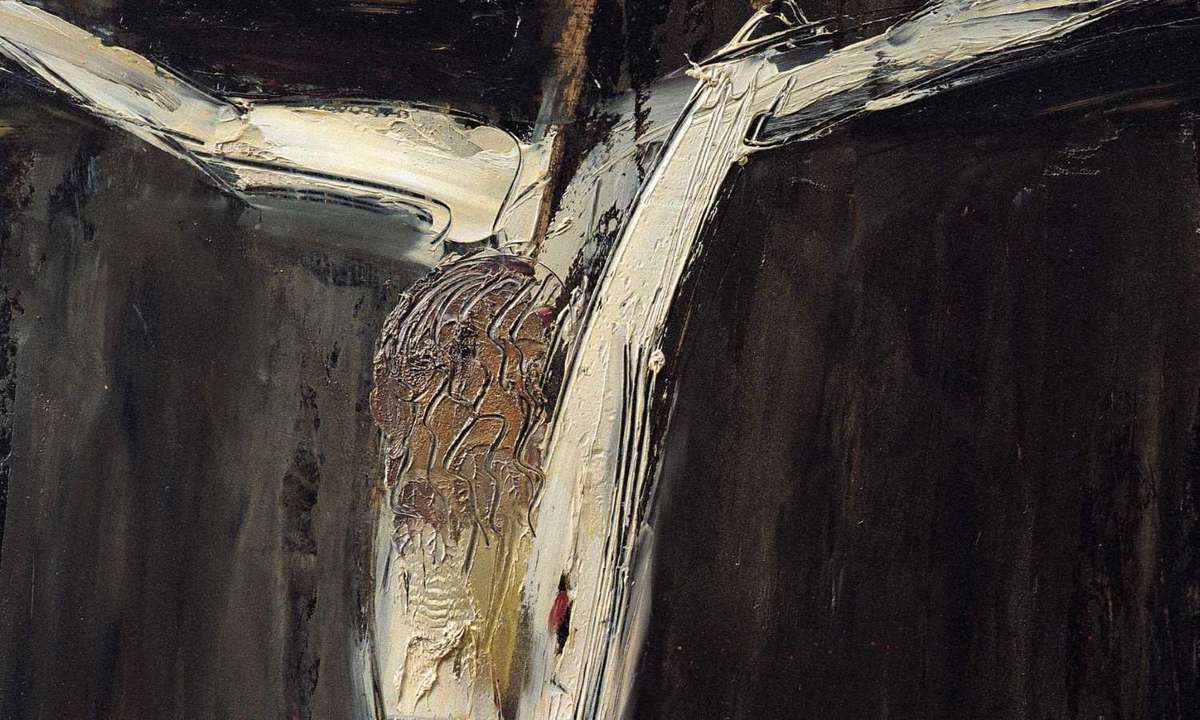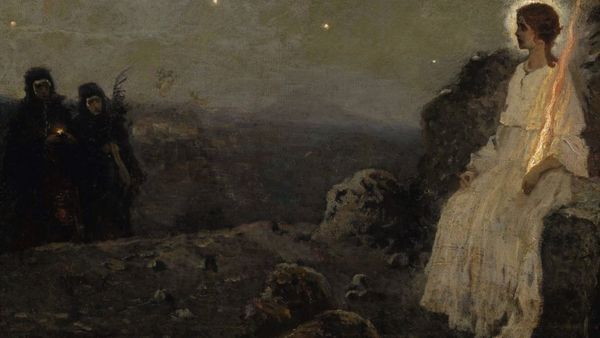The predominant Christological concept governing William Congdon’s 1960 painting “Crucifix no. 2” is that of kenosis. The painting conveys a sense of abject abandonment, leaving no doubt that Christ’s self-sacrificial act of obedience, “to the point of death—even death on a cross” (Phil. 2:8), is indeed an ultimate form of self-emptying, and especially so, not in spite of, because of his being the God-Man. Beyond this immediate kenotic impression conveyed by the work, the Christological insights of Hans Urs von Balthasar can flesh out further the significance of this particular representation of Christ. How we understand Christ’s relationship to his mission and the significance of this relationship in Congdon’s image will be our focus. Then we will consider what it means to involve ourselves in the viewing of Christ’s mission–as Congdon’s representation does—especially in light of the fact that Christ is the ultimate form of revelation, the image that in fact structures all revelation. We shall ultimately see that theological reflection and artistic representation inform and draw out the deepest meanings of one another so as to enrich our understanding of Christ’s mission and Person.
What does “Crucifix no. 2” say to us about Christ’s mission, and how ought we to think about his mission in reference to this image? The most important thing to note here is the backdrop against which the crucified Christ hangs: darkness, with no defined Cross. There is an ambiguously darker area surrounding his body, but it suggests itself rather as a variation of the ambient abyss than as an individuated entity. The Cross, the instrument of death, has faded either into the dark background or into Christ’s body, and Congdon’s painting leaves no explicit mediation between the crucified Christ and the emptiness surrounding him. There is an immediacy depicted between the emptiness of darkness and the emptiness of death, and the viewer is not given the opportunity to objectify the event in a piece of wood and distinguish it representationally from the divine actor. Rather, we are left with nothing to view but the event itself, which is the utter abasement of the God-Man. Balthasar’s mission-centric Christology thus receives exemplary representation in Congdon’s piece: “Jesus Christ dedicates his whole self to his mission: he is entirely one with it.”[1] In fact, “he is the one who, from before all time, has had the task–indeed, he is the task–of fulfilling this universal design.”[2] Christ is the task: as we contemplate this, we can look at Congdon’s piece and realize that here Christ is the Cross. What is more, the brush strokes, the angle of his arms, and the tailored legs and feet even convey a sense of downward motion, a literal pouring out. Visually, then, the event (the motion of emptying), the instrument (the Cross), and the Person become one.
On first sight of the painting, the viewer is struck by this sense of downward motion and by what appears to be a tendency towards a moderated formlessness. As we continue to examine the image, however, we can detect an unexpected degree of anatomical precision and deliberation. Most prominent both anatomically and visually are the jutting ribs and the slim (emaciated) waist, but a good deal of attention has also been given to the (over-)contracted scapulae, the sweaty and bloody globs of hair, and even a faint belly button. It is worth noting briefly how this form that becomes decipherable in the midst of apparent formlessness functions as an analogue to the limited understanding granted to the eyes of faith in the face of the mysteries of faith. As the painting is engaged patiently and carefully (reciprocating the love that it represents), it reveals more of itself to the viewer even while remaining permanently enshrouded in the mysterious darkness that surrounds it. What is particularly significant, having taken note of the unexpected anatomical detail, is one blatantly unrealistic feature that Congdon has depicted: Christ’s head hangs impossibly low and is turned in on his body.
On an initial analysis, this detail accentuates the kenotic nature of Christ’s death; it emphasizes the loss of any self-sustaining capacity remaining to him. However, bearing in mind Balthasar’s mission-centric Christology, we can draw deeper implications from the dramatic hanging of Christ’s head. The head is sunk to such a level that Christ is in fact turned in on his body, viewing the situation of his own Crucifixion. Two levels of observation open up: Christ becomes an observer of this event, internal to the representation of it, while at the same time we stand as external observers of it. Congdon creates the impression that Christ is at once the agent and an “observer” of this salvific act. Yet these two aspects of his action are not divisible, for they occur internally to the image, and his observation is a dimension and function of the action: his head hangs low and turns in on his body precisely because he has been so abased. Thus we see that, in this ultimate manifestation of his love, the “task given him by the Father, that is, that of expressing God’s Fatherhood through his entire being, through his life and death in and for the world, totally occupies his self-consciousness and fills it to the very brim.”[3] Once we are attuned to the place of mission in Christ’s consciousness, the painting drives home the intimate connection that exists between the prominence mission has in that consciousness and the nature of that mission. It is because of the nature of the event, of death on a cross, that Christ’s head and gaze droop so low as to be confronted entirely and only with his own death. While mission defines his conception of self and his relationship to his Father throughout his life, we are able to see this fact displayed dramatically and corporeally in this most intense moment of his earthly kenosis.
We can pursue this point further, in reference to the painting, by considering what it means to say that in his life Christ constantly reveals and looks to the Father. Balthasar is much attuned to the emphasis that John’s Gospel gives to the relationship between Jesus as the One sent and the Father as the One who sends. Indeed, “the One who sends is seen to be present in the One who is sent,” and the latter’s “whole being is in motion toward [the Father]: he is returning to him.”[4] It is because of this Sender-Sent relationship that Christ both reveals and looks to the Father at every moment of his earthly life. “[When] Jesus views his mission,” Balthasar observes, “his gaze discerns the Father who is behind it—it is the Father who ‘shows him all things’ (Jn 5:20).”[5] However, as has been noted, in Congdon’s painting Christ’s gaze is turned in on his own crucified body against a backdrop of darkness. What then does this tell us about the Father? The Father is evidently seen in the giving forth of Christ from his own indecipherable darkness. Thus Christ’s mission-consciousness, his attentiveness to his mission wherein he discerns the Father, in fact reflects the kenosis internal to the immanent Trinity. The Father begets, gives forth, and represents himself in Christ out of the depths of his own fundamental un-representability. In his consciousness of his sent-ness, Christ looks to the Father and reveals the Father’s will, but, even as revelatory, Christ cannot be separated from the concealment of the Father’s ineffable darkness whence he comes forth. The darkness of the backdrop and the lack of any material mediation through a physical cross indicate, for the viewer’s gaze, the simultaneous revelation and concealment of the Godhead and, for Christ’s, the depth of the Father’s presence in his own activity.
We said earlier that Congdon’s painting represents, in a sense, two visions and two levels of observation: the image with which Christ is presented and the image with which we the viewers are presented. Theological analysis of the painting gives us insight into the interplay between these two levels. As Balthasar has pointed out, Christ is always looking to his mission, moving toward the Father, and thus discerning the Father. Congdon’s Crucifixion gives dramatic representation to this fact: Christ discerns the Father precisely in the ugliness of his own death and in the blackness of the enveloping abyss. Not only this, but, insofar as the sacrifice on the Cross is the height of Christ’s mission, Christ discerns the Father especially in this moment. The dynamics of the economic Trinity while Christ hangs on the Cross reiterate the kenotic nature of the immanent Trinity. Christ sees the Father most clearly in the height of his own kenosis: he thus discerns the essentially self-emptying activity of the Father with respect to himself. On the level of viewership internal to the painting, then, Christ views the inner drama of the Godhead. But in this same moment, in his viewing of his mission and thus of the Father, he makes viewable the Father and the will and love of God. This is to say that one and the same painting (or, historically, one and the same life on earth) shows Christ’s viewing and invites us into that viewing–to view that viewing which is a constant return to the Father and thus to become involved in Christ’s own mission and activity.
Christ’s death and his viewing thereof becomes, then, the form of divine revelation, for “Whoever has seen me has seen the Father” (John 14:9), and we see Christ in the full intensity of his mission (and so in the full intensity of his Person) finally on the Cross. Indeed, Balthasar writes that the form of revelation in Christ “really is the crowning recapitulation of everything in heaven and on earth,” and so it is also “the form of all forms and the measure of all measures, just as for this reason it is the glory of all glories of creation as well.”[6] On this second level of viewership–our viewing of Christ’s kenosis–we are given the measure by which we are to understand the world (as recapitulated in Christ) and the final insight into who God is (One who “has committed himself unsurpassably and beyond all return”[7]), for “the revelation in the creation is seen to have occurred for the sake of the revelation in Christ, serving as the preparation that made it possible.”[8] Creation is always “thrown into existence,” liable to conceal or to reveal its origins, but the recapitulation of creation in Christ definitively determines the created as a manifestation of God’s outpouring love and freedom.
In this light, considered from the perspective of the viewer external to Congdon’s painting, the dark abyss behind the Crucified assumes another valence, that of an equivocating creation, concealing and revealing God’s glory. Insofar as we allow the created order to conceal God, it darkens the visibility of his glory to the viewer; and yet, creation remains the realm in which the outpouring love of God is made manifest in Christ and his Crucifixion. The downward motion of the hanging body that Congdon evokes in his painting at once structures the image and appears to pour out of the background, and so the form of Christ, falling or pouring itself down out of the blackness of fluid creation, determines once and for all the true reading of the world. The world makes manifest the non-manifest, as Christ makes visible the invisible God. Of course, Christ has priority in this analogy, for he does this in such a way as to make possible the understanding of the world so that it is seen in its true light. Thus the darkness of the painting is made “light” by the crucified Christ. Its mystery has not been eradicated; rather, the darkness, once a concealment of the divine glory, is now the revelation of the non-manifest that stands behind visibility. “For, what is manifested in a given manifestation is always, at the same time, the non-manifest,” Balthasar writes.[9] Creation is revelatory when it leads us beyond it to the darkness of the non-manifest divinity. Christ is the form of revelation—in this painting, a form that tends towards formless self-emptying—because in his external manifestation (his Incarnation) he orders creation so that it points to the mystery of its non-manifest Creator. The darkness enshrouding Congdon’s crucified Christ reminds us further that God remains fundamentally free even despite this external expression. His revelation in Christ represents his “ability to squander [himself] in love,” and this revelation of squandering is never to be separated from the darkness and freedom whence it springs forth.[10] Creation, the manifest and external, always exists in the “darkness” of divine freedom and transcendence.
Congdon’s painting “Crucifixion no. 2” invites and even demands theological analysis and reflection. Likewise, our abstract thoughts about Christ require some sort of representational articulation. Congdon’s painting impresses us initially on a visceral level with its abject depiction of Christ. When this visceral representation is put in dialogue with theological reflection, it becomes clear that our instinctive response accesses some preliminary truths of the faith that can be productively developed further with the help of systematic reflection. The bare fact of Christ’s sacrifice speaks to us on a deep, non-rational level about who God really is. With the low-hanging head, the outpouring Christ, and the darkness surrounding him, Congdon’s image evokes in us a consciousness of God’s outpouring nature. At the same time, the image is highly susceptible of fruitful systematic elaboration. Our reaction to Christ’s abasement in the painting becomes as it were the raw material of theological interpretation, allowing and eliciting a deeper penetration of the meaning of Christ’s kenotic mission. Following this incitement to further analysis spurred by the image, we are able to arrive at a more profound appreciation of just how profound our abstract theological commitments are. We are made to see that it is such an event as this that expresses the highest truths of the faith and indeed of God’s own nature.
[1] Hans Urs von Balthasar, Theo-Drama, Theological Dramatic Theory, Vol. III: Dramatis Personae: Persons in Christ, trans. Graham Harrison (San Francisco: Ignatius Press, 1992), 166.
[2] Ibid., 167-8.
[3] Balthasar, Theo-Drama, Vol. III, 172.
[4] Balthasar, Theo-Drama, Vol. III, 153.
[5] Ibid., 168.
[6] Balthasar, The Glory of the Lord: A Theological Aesthetics, Vol. I: Seeing the Form, trans. Erasmo Leiva-Merikakis (San Francisco: Ignatius Press, 2009), 422.
[7] Balthasar, The Glory of the Lord, Vol. I, 429.
[8] Ibid., 421.
[9] Ibid., 430.
[10] Balthasar, The Glory of the Lord, Vol. I, 431.


